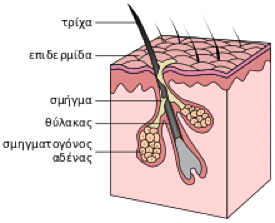 Anatomy of the scalp
Anatomy of the scalp
The scalp comprises of two basic layers, epidermis, the visible part of the skin and Chorion which is responsible for proper nutrition of the hair follicles it contains.
More specifically, the epidermis consists of different cell categories like small basal cells, melanocytes, dendrocytes and keratinocytes which form the majority of the epidermis cells. Keratinocytes are formed at a deeper point in the epidermis and comprise cell groupings so as to form a cell layer at the uppermost part of epidermis which consists of dead cells.
Chorion (Dermis), namely the main part of the skin, is the part which lies under the epidermis. These two layers are joined by the basic membrane, while it is now known that chorion is by far thicker than epidermis. The basic component of this layer is collagen; there are further most important components such as subcutaneous fat, nerve endings, sensors, capillaries, perspiratory and sebaceous glands as well as the heads of hair follicles. Capillaries play a vital role in the health of the hair as it is them which transport all the necessary substances and oxygen to the hair follicle. Sebaceous glands are also the ones which can produce sebum which hydrates the scalp. Finally, capillaries are where hair stems from.
More specifically, hair follicles comprise of nerves, capillaries, sebaceous glands, even a muscle which is responsible for hair erection (erector pili), consequently they are considered a complete biological unit. Follicles may bear one to four hairs depending on where they are located, what the age of the person is and other parameters. It is a fact though that the front part of the scalp (Front Line) bears follicles of one hair, while as we proceed deeper along the scalp the number of hairs on each follicle increases. Follicles are enveloped in a protective layer of collagen and appear not only on the scalp but throughout the skin with the exception of areas such as foot soles, palms, etc. It is notable that the number of hair follicles for every individual is determined genetically, the number of hairs though, as well as the quality of hair each hair follicle bears can vary within the life of an individual.
Parts and Composure of the hair
The Hair is the biological material that stems from the skin (hair follicle) the main substance of which is a protein called keratin which is produced at the stem cells at the bulb of the hair. Keratin makes hair strong and elastic. Besides keratin the hair consists of elements such as lipids, water, minerals and polysaccharides. There exist three kinds of hair, embryonic fuzz which develops and is usually cast off before birth, fuzz which is soft and indecipherable as it bears little or no pigment, and finally the Complete Hair which is the obvious hair growth on the body and the scalp and whose hair follicles bear sebaceous glands. The parts of the Complete Hair are two, the Root (Follice) and the Shaft.
The Follicle is the part which is not visible and lies within the hair follicle and terminates in the bulb. One of the most important parts of the hair follicle as regards the health of the hair is its basis. It is there where we find capillaries responsible for transporting all nutrients essential for the hair to develop properly. It is at this point where the androgen receptors lie. These are hormones which play a fundamental part in the quality and quantity of hair of the scalp.
The Shaft is the visible part of the hair. It is composed in most cases of three parts. First part is the epidermis of the hair which comprises of translucent cells in a wave formation. Going deeper we meet the bark of the hair, this part is composed mainly of keratin which is the protein that allows the shaft to develop. The bark is the part of the hair which defines the colour as well as the shape of the hair. Finally, the hair of great caliber also comprises the hair marrow which forms the heart of the shaft.









Get Connected